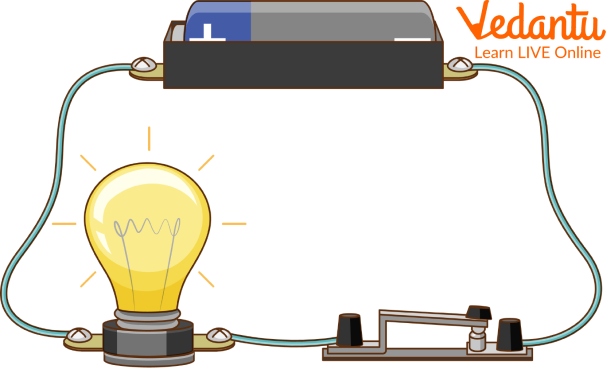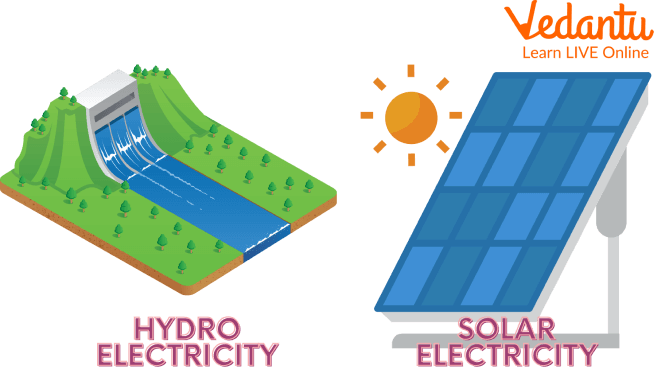




What Is Electricity? Key Facts, Types and Applications for Students
Electricity is a type of energy that can be found all around us. It is used to power our homes, businesses, and appliances. Electricity in science helps us understand how machines work. As we know, electrons are negatively charged particles. These particles move around when they come into contact with other materials, such as metal wires. This movement creates an electric current, which can be used to power devices and machinery. This article will be a great resource for kids who need help understanding electricity, what are the types of electricity, and how electricity works.
What is Electricity?
Electricity is a movement of charge, and charge carriers are called electrons. Electricity is a form of energy. Electricity is the flow of electrons such as electrons jumping from one place to another, such as running a hand over the carpet. The electricity is called static. If the charge carriers flow through a single medium, such as a wire, the electricity is called a current.
How does Electricity Work?
Electricity must travel in a closed circuit, which means it must follow a complete path from one place to another. When you turn on a light in your home, you close a circuit and allow power to flow to a specific appliance. By turning off the same power switch, you reopen the circuit and restrict the flow of electricity. And this is the way electricity works.

Working of Electricity
Now you must be wondering, where does your electricity come from? In general, the provider that provides services to your address will determine where your electricity originates from. Some utility companies and energy suppliers, for example, may own the power plants that generate their electricity, but others may choose to buy it from a third-party vendor.
Extra electricity can be created and stored during periods of low demand until demand increases again. Electricity can be stored in a variety of ways, including compressed air and batteries.
What are the Types of Electricity?
1. Static Electricity: The discharge of an electrical pulse known as Static Electricity is caused by an imbalance between the positive and negative charges within an object.
2. Current Electricity: The flow of electrons from one segment of the circuit to another is characterised as current electricity.
3. Hydro Electricity: It is a type of hydropower in which the kinetic energy of moving water is converted into electricity. Working on this cycle requires solar energy as well. The Sun is crucial in driving the water cycle and maintaining the natural process's consistency. Under gravitation, hydro-energy can be transferred to kinetic energy, which causes it to rotate.
4. Solar Electricity: Solar photovoltaic cells are used to convert sunlight into electricity. This is accomplished through the excitation of electrons in silicon cells, which consume photons from the Sun. This electricity is then available for use in your homes and businesses.

Hydro and Solar Electricity
Uses of Electricity in Science
Following are the uses of electricity in science:
Uses of Electricity in Healthcare: The most common use of electricity in healthcare is during Surgical procedures. During a patient's operation, doctors require bright light and the operation could be fatal if there is no electricity.
Uses of Electricity in Engineering: Buildings and structures for people's convenience necessitate the use of energy at every stage. Building houses, installing gates and windows, and welding materials all necessitate the usage of current energy to power the machines.
Uses of Electricity in Space: Satellites and probes launched from Earth for space explorations are powered by electricity. Electricity is created via a generator or is battery powered. Without the use of electricity, the ISRO mission would not have been possible.
Uses of Electricity in Household: Electricity powers everything from a toaster to a refrigerator, microwave, washing machine, dishwasher, electrical chimney, and a plethora of other equipment designed to make daily life easier.
Electricity Facts for Kids
Electricity travels at the speed of light, which is approximately 300,000 kilometres per second.
A static electrical spark can measure up to 3,000 volts.
A lightning bolt can have a voltage of up to three million (3,000,000) volts (and lasts less than one second).
LED light bulbs consume roughly one-sixth of the electricity that conventional lights do, cost roughly a fourth as much to operate, and last roughly 40 times longer.
Electricity causes the muscle cells in your heart to contract, causing it to beat. Electrocardiogram (ECG) equipment records the electrical activity of the heart. The ECG equipment displays a line travelling across the screen with regular spikes when a healthy person's heart beats (as you've seen in a hundred movies and TV shows).
Certain muscle cells in some Amazon River fish have evolved over millions of years into electrolytes, which they employ for echolocation, or detecting obstacles and other creatures in the dark.
Summary
Electricity is a powerful force that we use every day. Electricity is generated by the movement of tiny particles called electrons. These particles move around when they come into contact with other materials, such as metal wires. It is the backbone of ultramodern society. Without electricity, our lives will revert to those of the primitive era. There's a need for rational use of electricity, as it's largely produced from non-renewable sources like coal and water. This article has helped us to understand the basics of electricity, including what it is, where it comes from, and some of its uses.
FAQs on Electricity: Concepts, Types & Everyday Uses
1. What will happen without electricity?
Your freezer and refrigerator wouldn't work, and the phone lines and signal would be down. With no backup charging option, your mobile phone would become unusable.
Your water supply would soon stop flowing clean water, and your gas central heating would not function. More than ever, we depend on electricity for practically all of our tasks, from simple tasks like charging a phone to operating large industrial machinery.
2. How does electricity affect our lives?
Electricity is an essential part of modern life and important for us. People use electricity for lighting, heating, cooling, and refrigeration and operating appliances, computers, electronics, machinery, and public transportation systems.
3. What are the main hazards of electricity?
The main hazards of working with electricity are electric shock and burns from contact with live parts. Injury from exposure to arcing, fire from faulty electrical equipment or installations.























